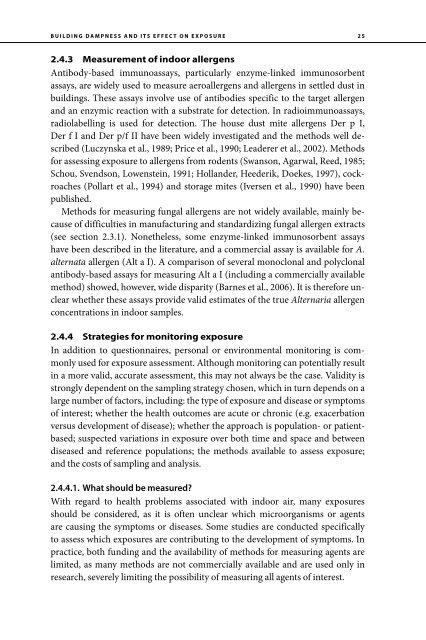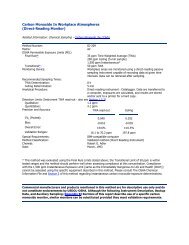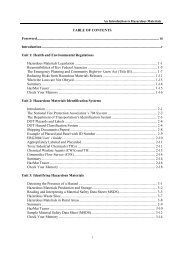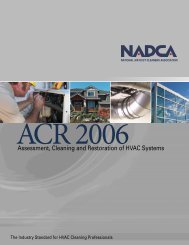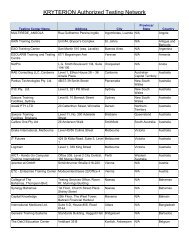Dampness and Mould - WHO guidelines for indoor air quality - PRWeb
Dampness and Mould - WHO guidelines for indoor air quality - PRWeb
Dampness and Mould - WHO guidelines for indoor air quality - PRWeb
You also want an ePaper? Increase the reach of your titles
YUMPU automatically turns print PDFs into web optimized ePapers that Google loves.
BUILDING DAMPNESS AND ITS EFFECT ON EXPOSURE<br />
25<br />
2.4.3 Measurement of <strong>indoor</strong> allergens<br />
Antibody-based immunoassays, particularly enzyme-linked immunosorbent<br />
assays, are widely used to measure aeroallergens <strong>and</strong> allergens in settled dust in<br />
buildings. These assays involve use of antibodies specific to the target allergen<br />
<strong>and</strong> an enzymic reaction with a substrate <strong>for</strong> detection. In radioimmunoassays,<br />
radiolabelling is used <strong>for</strong> detection. The house dust mite allergens Der p I,<br />
Der f I <strong>and</strong> Der p/f II have been widely investigated <strong>and</strong> the methods well described<br />
(Luczynska et al., 1989; Price et al., 1990; Leaderer et al., 2002). Methods<br />
<strong>for</strong> assessing exposure to allergens from rodents (Swanson, Agarwal, Reed, 1985;<br />
Schou, Svendson, Lowenstein, 1991; Holl<strong>and</strong>er, Heederik, Doekes, 1997), cockroaches<br />
(Pollart et al., 1994) <strong>and</strong> storage mites (Iversen et al., 1990) have been<br />
published.<br />
Methods <strong>for</strong> measuring fungal allergens are not widely available, mainly because<br />
of difficulties in manufacturing <strong>and</strong> st<strong>and</strong>ardizing fungal allergen extracts<br />
(see section 2.3.1). Nonetheless, some enzyme-linked immunosorbent assays<br />
have been described in the literature, <strong>and</strong> a commercial assay is available <strong>for</strong> A.<br />
alternata allergen (Alt a I). A comparison of several monoclonal <strong>and</strong> polyclonal<br />
antibody-based assays <strong>for</strong> measuring Alt a I (including a commercially available<br />
method) showed, however, wide disparity (Barnes et al., 2006). It is there<strong>for</strong>e unclear<br />
whether these assays provide valid estimates of the true Alternaria allergen<br />
concentrations in <strong>indoor</strong> samples.<br />
2.4.4 Strategies <strong>for</strong> monitoring exposure<br />
In addition to questionn<strong>air</strong>es, personal or environmental monitoring is commonly<br />
used <strong>for</strong> exposure assessment. Although monitoring can potentially result<br />
in a more valid, accurate assessment, this may not always be the case. Validity is<br />
strongly dependent on the sampling strategy chosen, which in turn depends on a<br />
large number of factors, including: the type of exposure <strong>and</strong> disease or symptoms<br />
of interest; whether the health outcomes are acute or chronic (e.g. exacerbation<br />
versus development of disease); whether the approach is population- or patientbased;<br />
suspected variations in exposure over both time <strong>and</strong> space <strong>and</strong> between<br />
diseased <strong>and</strong> reference populations; the methods available to assess exposure;<br />
<strong>and</strong> the costs of sampling <strong>and</strong> analysis.<br />
2.4.4.1. What should be measured?<br />
With regard to health problems associated with <strong>indoor</strong> <strong>air</strong>, many exposures<br />
should be considered, as it is often unclear which microorganisms or agents<br />
are causing the symptoms or diseases. Some studies are conducted specifically<br />
to assess which exposures are contributing to the development of symptoms. In<br />
practice, both funding <strong>and</strong> the availability of methods <strong>for</strong> measuring agents are<br />
limited, as many methods are not commercially available <strong>and</strong> are used only in<br />
research, severely limiting the possibility of measuring all agents of interest.


